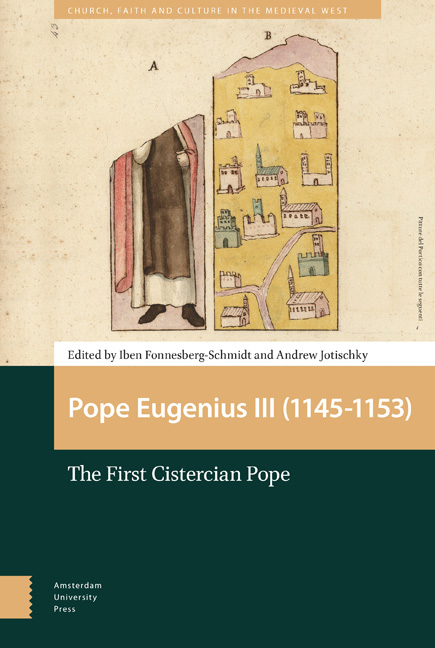Book contents
- Frontmatter
- Contents
- Preface
- Abbreviations
- Maps and Figures
- Introduction
- 1 ‘Justinian’s Laws, not the Lord’s’: Eugenius III and the Learned laws
- 2 Curial Politics and Papal Power : Eugenius III, the Curia, and Contemporary Theological Controversy
- 3 The Cistercians, Eugenius III, and the Disputed York Election
- 4 Eugenius III and the Crusades to the East
- 5 Eugenius III and the Northern Crusade
- 6 The Benefits of Exile
- 7 Eugenius III and France: the Protected Protector
- 8 A Golden Rose and the Deaf Asp that Stoppeth her Ears: Eugenius III and Spain
- 9 Eugenius III and the Roman Commune
- 10 Eugenius III Reclaims the Patrimony of St Peter
- 11 Eugenius III’s Privileges to Cistercian Houses
- 12 Eugenius III at Cîteaux, 1147
- 13 Eugenius III and the Church in the Crusader States
- Index
13 - Eugenius III and the Church in the Crusader States
Published online by Cambridge University Press: 22 December 2020
- Frontmatter
- Contents
- Preface
- Abbreviations
- Maps and Figures
- Introduction
- 1 ‘Justinian’s Laws, not the Lord’s’: Eugenius III and the Learned laws
- 2 Curial Politics and Papal Power : Eugenius III, the Curia, and Contemporary Theological Controversy
- 3 The Cistercians, Eugenius III, and the Disputed York Election
- 4 Eugenius III and the Crusades to the East
- 5 Eugenius III and the Northern Crusade
- 6 The Benefits of Exile
- 7 Eugenius III and France: the Protected Protector
- 8 A Golden Rose and the Deaf Asp that Stoppeth her Ears: Eugenius III and Spain
- 9 Eugenius III and the Roman Commune
- 10 Eugenius III Reclaims the Patrimony of St Peter
- 11 Eugenius III’s Privileges to Cistercian Houses
- 12 Eugenius III at Cîteaux, 1147
- 13 Eugenius III and the Church in the Crusader States
- Index
Summary
Abstract
Eugenius arbitrated in tithe disputes between the monastery of St Mary of Josaphat in the Kidron Valley and Robert, archbishop of Nazareth, and on jurisdictional issues such as the patriarchal claims of Jerusalem and Antioch to primacy over the archbishopric of Tyre. In 1149, when the new church of the Holy Sepulchre was consecrated, the pope sought information on Orthodox doctrine, perhaps inspired by the consecration of the new church of the Holy Sepulchre in 1149 with an altar set aside for the Greek liturgy. Exceptionally, he invited an Armenian delegation to attend a Mass at St Peter's to observe Catholic practice, and displayed interest in the Orthodox liturgy in Jerusalem as part of his universal ministry over all churches .
Keywords: church of the Holy Sepulchre; Notre-Dame de Josaphat; Bethlehem and Mt Sion; Armenia
Historians of the crusades are accustomed to thinking of Eugenius III chiefly as the pope who initiated the Second Crusade. So large do the crusade of 1146–8 and its planned but unfulfilled successor of 1150 loom in Eugenius's short pontificate that Rudolf Hiestand has asserted that it was ‘without doubt the central event in the pontificate of Eugenius’. The weight of attention paid to the Second Crusade over the past twenty years has added to this perspective. The intricacies of the language and timing of his crusading bull, and the intentions behind it, the attitudes of Eugenius and the Cistercians to a further attempt to launch a crusade in 1150, and papal crusading policy in general in Eugenius's pontificate, have been analysed rigorously.
Given the importance of crusading as an activity of Eugenius's pontificate, it is perhaps understandable that less attention has been paid to the apparently more mundane business of his pontificate relating to the Church in the Crusader States. Yet, as Hiestand himself acknowledged, the wider context of the preaching and planning of the Second Crusade must take into account the increased involvement of the papacy in the ecclesiastical affairs of the Crusader States from the 1130s onward. Petitions to the papal Curia from the churches of the Crusader States increased markedly under Innocent II (1130–43), and even the brief pontifical reigns of Celestine II (1143–4) and Lucius II (1144–5) bear evidence of this continuing trend.
- Type
- Chapter
- Information
- Pope Eugenius III (1145–1153)The First Cistercian Pope, pp. 341 - 358Publisher: Amsterdam University PressPrint publication year: 2018

